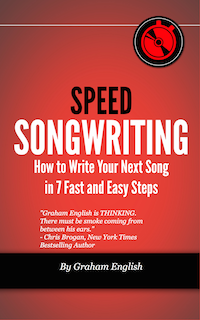
Songwriting doesn’t have to be a marathon.
The secret to writing better songs faster isn’t working harder; it’s working smarter.
Whether you’re juggling deadlines, chasing inspiration, or just trying to make the most of a packed schedule, these five time-saving tricks will help you reduce procrastination and skyrocket your productivity.
1. Set a Songwriting Timer
Deadlines spark creativity. Give yourself a hard stop for each writing session by setting a timer.
Here’s how to make it work: Choose one task—like brainstorming lyrics or building a chord progression—and set a timer for 25 minutes (this is known as the Pomodoro Technique). Focus exclusively on that task until the timer buzzes. Then, take a five-minute break. Repeat this cycle for two hours max.
Why it works? A timer turns songwriting into a game. The ticking clock creates urgency and eliminates distractions. You’re not writing the perfect song—you’re just moving forward.
For example, instead of getting lost tinkering with the same two lines for hours, you’ll brainstorm 20 lyric ideas in 25 minutes. The pressure gets your brain into high gear. And when the timer rings, you’ll already have material to build on.
Try this mind hack: Start your next session with “25 minutes to write the worst verse ever.” You’ll surprise yourself with how fast ideas flow when you lower the stakes.
2. Pre-Plan Your Writing Sessions
Imagine walking into a kitchen without knowing what to cook. You’d waste half the time opening cabinets and debating recipes. Songwriting works the same way. Pre-planning avoids this kind of creative chaos.
The night before a session, jot down your goal for the next day. Be specific. Instead of writing “work on a song,” write “finish the first verse and chorus of the love song.” Pick your key, tempo, and even a reference track.
To streamline even further, create templates in your DAW. For instance, save a basic setup with your go-to piano patch, drum loop, and vocal chain. When you sit down to write, you’re diving straight into the music, not fiddling with plugins.
Here’s a bonus tip: Make an “idea bank.” Spend a separate session collecting lyric snippets, melodic hooks, or chord progressions you like. When it’s time to write, you’ll have raw materials at your fingertips.
3. Use the “Minimum Viable Song” Approach
Stop aiming for perfection on the first draft. Instead, think of your song as a rough prototype. Focus on writing the minimum viable song—a stripped-down version with a verse, a chorus, and maybe a bridge.
Why? Because a rough draft is easier to fix than a blank page. Don’t worry about the second verse rhyming perfectly or the melody soaring like Adele’s. Just get something down.
Here’s an example: Instead of agonizing over which chords to use, commit to G-D-Em-C and move on. Later, you can tweak the arrangement or try out inversions. Right now, the goal is momentum.
To practice this, challenge yourself to write a full song in 30 minutes. Yes, it might be bad. But in the process, you’ll often stumble upon great ideas hiding behind the noise. Polish comes later.
4. Batch Similar Tasks
Multitasking kills productivity. Instead of bouncing between brainstorming lyrics, tweaking drum loops, and recording vocals, try batching similar tasks. This keeps your brain in the same gear, so you stay in flow longer.
Here’s what to do: Dedicate one session to a single type of work. Spend 45 minutes generating lyric ideas. Another session can focus on building loops. And when you’re scheduled to record, lay down vocals for multiple tracks in one sitting.
Take this example: Say you’re working on three songs. Rather than writing one complete song before moving to the next, spend Monday drafting lyrics for all three. On Tuesday, focus on chords and melodies. By the end of the week, you’ll have three songs moving toward completion simultaneously.
5. Limit Your Options
Options are the enemy of speed. When you’re overwhelmed by 300 synth presets or scrolling endlessly for rhymes, it’s hard to stay focused. Instead, set strict limits on your choices.
Pick one drum kit, one bass sound, and one lead instrument before you start. Stick to them for the session. Even better, create a songwriting “palette” for your project: a predefined selection of sounds and styles to use across multiple songs.
For lyrics, limit yourself to a short list of themes or imagery. If your song is about heartbreak, stick to visuals like shattered glass, empty chairs, and rain-soaked streets. Don’t let your mind wander into unrelated metaphors.
Here’s a quick experiment: For your next track, challenge yourself to write using only three chords. Think of what Billie Eilish did with "Ocean Eyes"—simple yet powerful.
Wrap-Up: The Power of Simplicity
Speed Songwriting isn’t about cutting corners. It’s about removing the obstacles that slow you down—overthinking, distractions, and too many choices. By setting a timer, pre-planning your sessions, aiming for minimum viable songs, batching tasks, and limiting options, you’ll work faster, create more, and actually enjoy the process.
The next time you sit down to write, remember: Progress beats perfection. Keep moving, and the music will follow.

Enter your first name and email address below and click “GET ACCESS NOW!” to get the Speed Songwriting Cheat Sheet delivered to your inbox!
We guarantee 100% privacy. Your information will not be shared.

Hi Graham
Happy holidays season! I’m a member who signed up years ago. Checking on website I can access agsin. Many thanks
Melinda e lopez
Happy holiday season to you, too! You can update your password here. Be sure to check the password requirements and troubleshooting tips on the page. Let me know if you need further help!
I would love to hear your advice on rewriting and improving. I have lots of songs that are complete, in the sense that they have a full set of lyrics, chords and melodies . . . But I don’t know how to start rewriting. Do you have a column (or several) about that?
Great question! Rewriting is such an important part of the songwriting process, and I’ll be sure to write more about it soon. In the meantime, a simple way to start is by focusing on one element at a time—like tightening lyrics, simplifying melodies, or improving chord progressions. Small changes can make a big impact!
Stay tuned—I’ve got plenty to share on this topic.